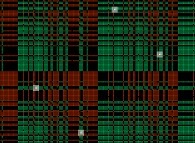
The Simpson paradox [Le paradoxe de Simpson].
The Simpson Paradox is based on the following phenomenon:
Let {n1,d1,n2,d2,n3,d3,n4,d4} be eight integer numbers such that:
n1 n2
---- < ----
d1 d2
n3 n4
---- < ----
d3 d4
Then:
\
n1 n2 |
---- < ---- |
d1 d2 | n1 n3 n2 n4
| ==> ---- + ---- < ---- + ----
n3 n4 | d1 d3 d2 d4
---- < ---- |
d3 d4 |
/
But unfortunately (and obviously) nothing can be said about:
n1 + n3 n2 + n4
--------- ? ---------
d1 + d3 d2 + d4
where '?' means '<', '=' or again '>'.
Nota: this wrong way for adding two rational numbers is the so-called Median-Mean.
The {n1,d1,n2,d2,n3,d3,n4,d4} space is a eight-dimensional one
and then difficult to visualize. In order to use a bidimensional space, for
{n1,d1,n2,d2,n3,d3,n4,d4} inside [1,5], the two
following coordinates are computed:
X = (((n1-1)*5 + (n3-1))*5 + (d1-1))*5 + (d3-1)
Y = (((n2-1)*5 + (n4-1))*5 + (d2-1))*5 + (d4-1)
Then, the white points {X,Y} display the case where:
n1 + n3 n2 + n4
--------- > ---------
d1 + d3 d2 + d4
the so-called paradoxal case...
For example:
1 2
--- < ---
3 4
4 2
--- < ---
3 1
when:
1 + 4 2 + 2
------- > -------
3 + 3 4 + 1
By the way {Black, Red, Green} colors are used for the 3x3x3-2=25 other cases...
See some related pictures (including this one):


More information on this subject
is
available in the july 2013 issue (#429) of PLS (Pour La Science)
with the Jean-Paul Delahaye's paper L'embarrassant Paradoxe de Simpson.
See my own discovery of the "double" Simpson Paradox on 03/20/2013 -in french-:
Afin de tester l'efficacité d'un nouveau médicament, il va être testé sur 183 patients
(soit 91 hommes et 92 femmes): 89 vont prendre ce médicament et aux 94 autres, c'est un placebo qui sera administré.
L'expérience suivante montre que suivant le tri qui sera fait entre les malades (par exemple observer l'ensemble d'entre-eux [1],
ou bien uniquement les femmes [3] ou encore les hommes aux yeux foncés [7]), le résultat du test d'efficacité peut être inversé.
Ainsi, pour l'ensemble [1] c'est le médicament qui semble efficace, alors que pour les hommes aux yeux foncés [7] c'est le placebo.
Dans ces conditions, quelle est l'efficacité réelle de ce nouveau médicament?
1 : Général
| Guéri | Non guéri | Taux de guérison |
| Médicament | 47 | 42 | 52.80% |
| Placebo | 38 | 56 | 40.42% |
|
2 : Hommes
| Guéri | Non guéri | Taux de guérison |
| Médicament | 40 | 26 | 60.60% |
| Placebo | 16 | 9 | 64% |
|
3 : Femmes
| Guéri | Non guéri | Taux de guérison |
| Médicament | 7 | 16 | 30.43% |
| Placebo | 22 | 47 | 31.88% |
|
4 : Yeux Clairs
| Guéri | Non guéri | Taux de guérison |
| Médicament | 24 | 19 | 55.81% |
| Placebo | 21 | 28 | 42.85% |
|
5 : Yeux Foncés
| Guéri | Non guéri | Taux de guérison |
| Médicament | 23 | 23 | 50% |
| Placebo | 17 | 28 | 37.77% |
|
6 : Hommes Yeux Clairs
| Guéri | Non guéri | Taux de guérison |
| Médicament | 21 | 13 | 61.76% |
| Placebo | 8 | 5 | 61.53% |
|
7 : Hommes Yeux Foncés
| Guéri | Non guéri | Taux de guérison |
| Médicament | 19 | 13 | 59.37% |
| Placebo | 8 | 4 | 66.66% |
|
8 : Femmes Yeux Clairs
| Guéri | Non guéri | Taux de guérison |
| Médicament | 3 | 6 | 33.33% |
| Placebo | 13 | 23 | 36.11% |
|
9 : Femmes Yeux Foncés
| Guéri | Non guéri | Taux de guérison |
| Médicament | 4 | 10 | 28.57% |
| Placebo | 9 | 24 | 27.27% |
|
On a évidemment les relations suivantes entre les tableaux précédents:
Général = (Hommes) + (Femmes)
183 = 91 + 92
Général = (Yeux Clairs) + (Yeux Foncés)
183 = 92 + 91
Général = (Hommes Yeux Clairs) + (Hommes Yeux Foncés) + (Femmes Yeux Clairs) + (Femmes Yeux Foncés)
183 = 47 + 44 + 45 + 47
Hommes = (Hommes Yeux Clairs) + (Hommes Yeux Foncés)
91 = 47 + 44
Femmes = (Femmes Yeux Clairs) + (Femmes Yeux Foncés)
92 = 45 + 47
Yeux Clairs = (Hommes Yeux Clairs) + (Femmes Yeux Clairs)
92 = 47 + 45
Yeux Foncés = (Hommes Yeux Foncés) + (Femmes Yeux Foncés)
91 = 44 + 47
[See the C program used to obtain those results]
(CMAP28 WWW site: this page was created on 04/18/2013 and last updated on 04/18/2025 09:26:26 -CEST-)
[See all related pictures (including this one) [Voir toutes les images associées (incluant celle-ci)]]
[Please visit the related NumberTheory picture gallery [Visitez la galerie d'images NumberTheory associée]]
[Go back to AVirtualMachineForExploringSpaceTimeAndBeyond [Retour à AVirtualMachineForExploringSpaceTimeAndBeyond]]
[The Y2K Bug [Le bug de l'an 2000]]
[Site Map, Help and Search [Plan du Site, Aide et Recherche]]
[Mail [Courrier]]
[About Pictures and Animations [A Propos des Images et des Animations]]
Copyright © Jean-François COLONNA, 2013-2025.
Copyright © CMAP (Centre de Mathématiques APpliquées) UMR CNRS 7641 / École polytechnique, Institut Polytechnique de Paris, 2013-2025.



